And it’s time to crawl out through the fallout, under an orange coloured sky for the latest entry in the Pick Up Pile; Fallout the Roleplaying Game, the last of the newer games I got for Christmas. Just in time for the Amazon Prime series to land on April 11th. This game is available in physical form from most game stores, or direct from Modiphius themselves HERE. Alternatively PDF copies can be obtained from Drive Thru RPG HERE, or Modiphius HERE. Also I must mention that when you buy a physical copy of the game, from any retailer, Modiphius can be contacted for a free PDF as per the instructions HERE.
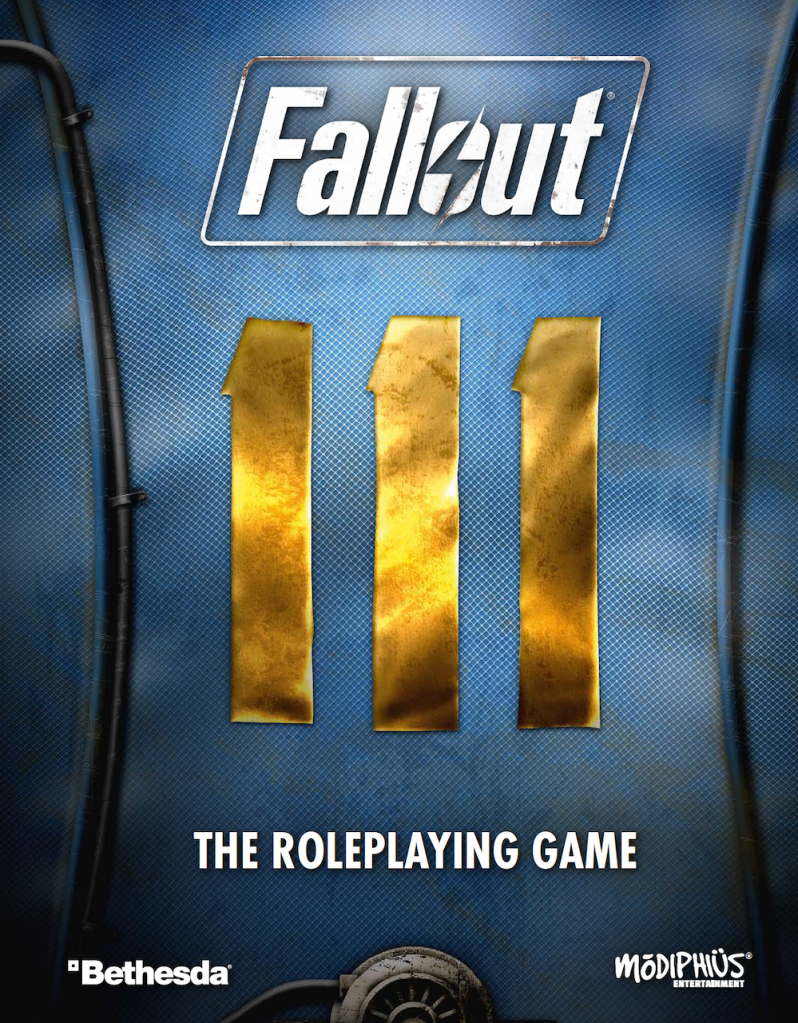
First up, as I usually do in these reviews is the physical description. A sturdy, 432 page book withe ribbon bookmark (have I mentioned too much how I love ribbon boommarks yet?). Pages are thin to keep the book from being overly bulky, but not fragile and feel like they’ll stand up to regular gaming use. The cover is blue, made to resemble the back of a Vault-Tec jumpsuit, with the number 111 on it, so those familiar with the Fallout videogames will already have an idea of the default setting in the game. The PDF is indexed and has clickable links in the contents page, however page references do not appear to be links. The PDF also came with an Errata document to check your copies are up to date. This was last updated Feb ’23 so any new copies should be updated to have all these corrections already.
So, when you crack open the book, what’s inside? The contents page lists out the Twelve chapters (plus intro). Welcome to the Wasteland, Core Rules, Combat, Character Creation, Equipment, and Survival cover rules thet concern everyone playing the game. Corporations of Pre-War America, Vault-Tec, and The Commonwealth are all setting details, both geographical and historical. Then you have Gamemastering, Denizens of the Wasteland, and With a Bang or a Whimper for the GM’s eyes only. These are followed by the Appendices, where you’ll find the index and the character sheets, which I won’t go in depth on other than to say the sheets are clearly laid out and fit the look of wverything else in the game.
The artwork throughout the book is brilliant, much of it seems to be concept art and illustrations from Bethesda themselves. A lot of it having been used in various Fallout game promotional things over the years. There are atmospheric two page spread before every chapter, and example illustrations everywhere. A fantastic amount of good quality art that breaks up the text nicely.
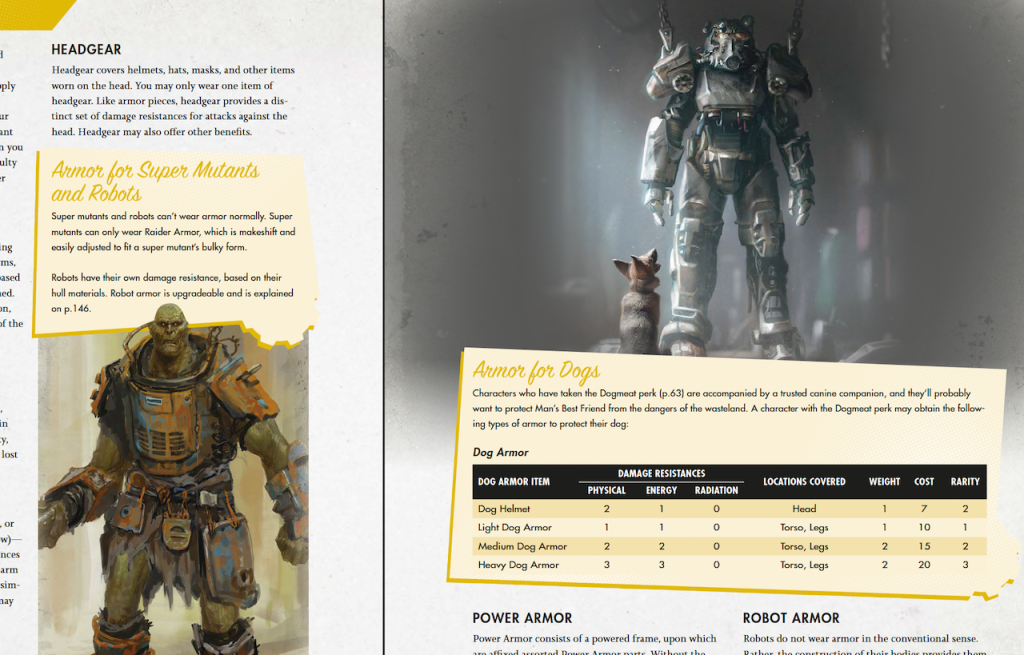
Welcome to the Wasteland is up first. These four pages give an overview of the game, the default setting (Boston as pre Fallout 4), and what you need to play aside from the book.
Chapter One proper is the Core Rules. Here we get the usual “What is a roleplaying game?” that we’re all familiar with. Useful, as I can see someone coming from the videogames to this as their first TTRPG. Then we have the core rule; pick an Attribute and Skill, set a difficulty, assemble a dice pool, roll under the attribute+skill total for a success. There is guidance for using metacurrency (Action Points, which can be earned from successes) to buy extra dice over the default roll of 2, opposed rolls, critical successes, complications, and using your Luck stat to change outcomes. These are all explained clearly and each has a worked example to show it in play. This is a nice clear reference section that gets over how things are done in the game.
Combat comes next with the chapter covering all the ways war never changes. initiative is a static number derived from your skills, so a party can soon learn which order they will always act in and use that to plan tactically. Turns are split into Major (Attacking, First Aid etc.) and Minor (Moving, Aiming etc.) actions, with the default being one of each per turn. Extra actions can be bought for Action Points. So you can spend AP to perform a queue of actions in a signal turn, which has a feel similar to using VATS in the videogames.
Hitting an opponent is a roll using the relevant skill and attribute against their Defence stat. Hit location is then rolled and damage after that. Resistance is subtracted from this total and the remainder applied to the victim. The damage dice are one of my annoyances with the game. Instead of rolling a dice and using that number you the options are to either use the proprietary dice available, or use the conversion chart in the book. The conversion is relatively simple, but it is an extra step that needs to be done with each hit, slowing things down.
The chapter then covers first aid and stabilisation during combat, and longer term healing for when things have calmed down afterwards. Range, environmental conditions, and other things that may have an effect in combat are also covered here.
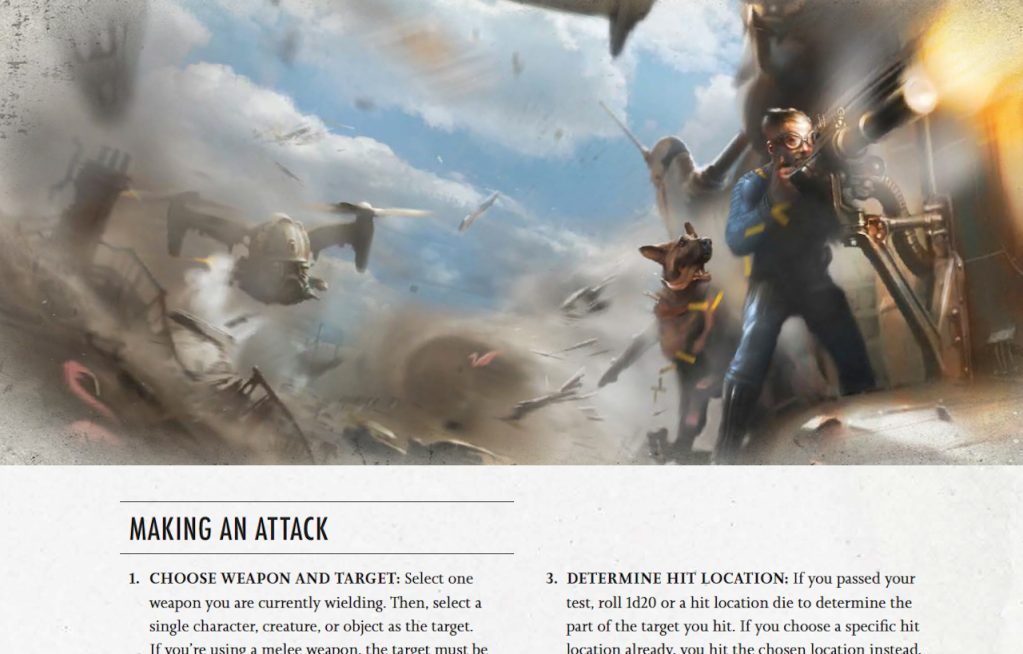
Mechanically, compared to the only other Modiphius game I own, Dune, which was a bit looser and more narrative focused, this is a nicely detailed version of the 2d20 system with clear inputs and outputs, much easier for me to grasp.
Next is Character Creation, the bit in a videogame RPG that takes most people hours, but is surprisingly quick here going by my test characters. During the Character Creation Challenge earlier in the year, I made all four of my characters in an afternoon.
First choose your origin; Brotherhood of Steel Initiate, Ghoul, Super Mutant, Mister Handy, Survivor, or Vault Dweller. A good mix of origins there so you can cover pretty much any character niche you’d like. Next you pick your attributes and they are the S.P.E.C.I.A.L. attributes used in the videogames. Then you pick skills and Tag skills which are ones where you have more advanced training and therefor a better chance of a critical success. Next comes your first perk, and it’s a loooooong list, a really good way of further specialising your character.
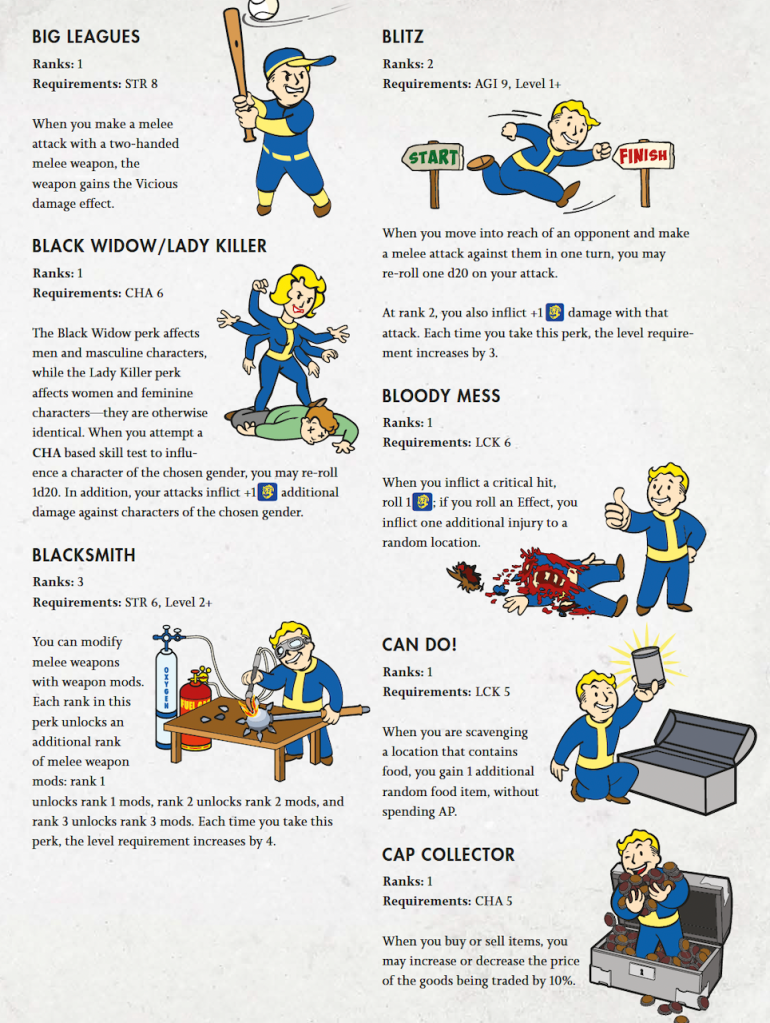
Derived statistics come next, these flesh out the last few mechanical parts of your character. Then you get equipment based on your Origin and Tag Skills. I found this to be a surprisingly straightforward creation system. If you have a definite vision of the wasteland wanderer you want to build it should be no problem.
The Equipment chapter follows this. There is a lot, think of all the gear in Fallout 4, yeah, it’s pretty much all written up here. Guns, bombs, lead pipes, mutfruit, Sugar Bombs, Power Armour… etc etc. The lot. With mods where applicable. We have rules here for obtaining equipment, modifying it, and special rules for weapon effects. Just over 100 pages of everything you can find in the game. Again with plenty of illustrations. If you like gear-porn sections in rulebooks, you’ll love this.
Chapter Five covers Survival. This is the last of the real rule sections. It leads with rules for food, drink, sleep, and disease exposure. These are marked as optional rules, similar to how survival options are optional in the videogames. So you can use or ignore these as suits your group.
Then we have Scavenging rules, another section that had something I didn’t like. For the rules for randomly generating locations and their contents one is told to consult the Gamemaster’s Toolkit, an entirely separate purchase. An experienced GM will be able to put something together from the included, very good, random loot tables. But a rule of thumb to guide you if you don’t have the extra rules would have been nice.
As mentioned the loot tables themselves are good. Most being a 2D20 roll with the bell curve weighted towards more mundane items, and rarer items towards either end where the result is less likely to occur. For example the armour table has a 1.5%to give an X-01 piece on a roll of 2-4, and a 5% chance to give Raider Armour on a roll of 21. Assuming my AnyDice graph is correct.


Finally in this chapter, there’s crafting. We get many more table here covering everything you can make at the various workbenches you can find in the wasteland. Each table covers the raw materials needed, the skill required to make the item and the perk required to be able to even attempt it. Another good section that replicates an aspect of the videogames.
The next three chapters are all reference material. Coroprations of Pre-War America, Vault-Tec, and The Commonwealth add up to around 80 pages of game background, geographical, social, and historical. The corporations are described in what they did before the war, what they mean after the war, and how to slot them into your game.
Vault-Tec is given a similar treatment in it’s own chapter. Then it covers each of the vaults in the Commonwealth area, the experiments carried out in each, and suggestions on how to use them in your game. Also there are random encounter tables for dungeon crawls vault exploration.
The Commonwealth chapter describes many key points of interest through the wasteland and several generic ones for dropping in anywhere. There are random encounter tables here for outside encounters. Finally this closes with some advice on themes and plots for games set in the region, from Pre-War Capitalism to Emancipation.
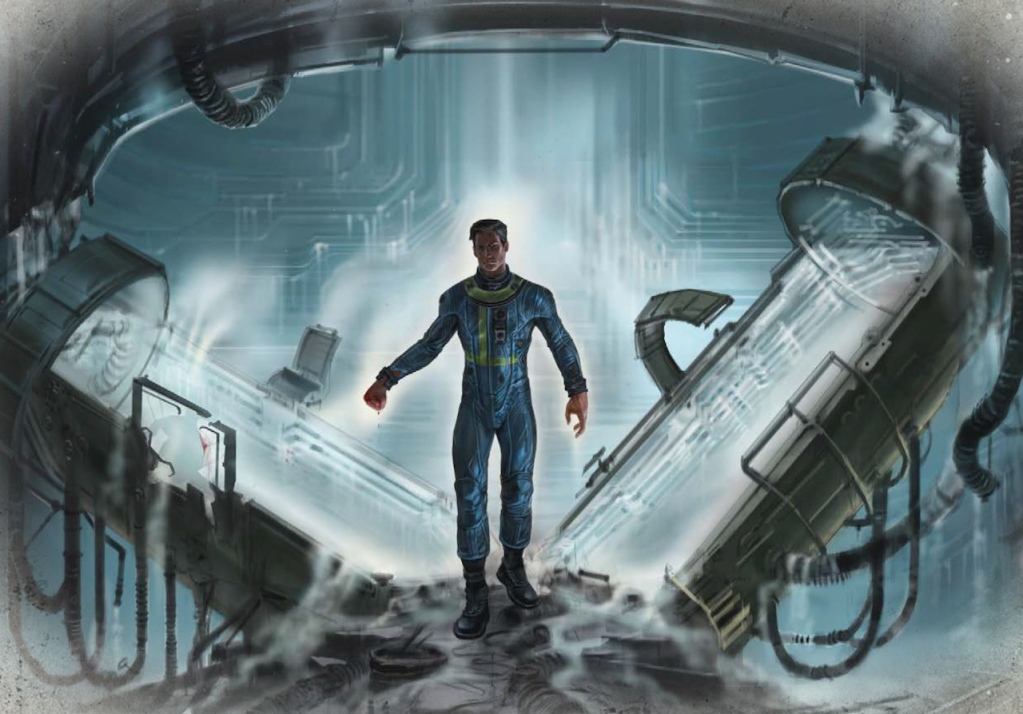
Throughout these chapters, where needed, entries have guidance on consulting with your players to make sure they are comfortable with the material if it is used in a game. For example the abusive family in Diamond city, or the themes of slavery and emancipation may not be for all tables. This book had some of the best guidance of this type I’ve seen in a mainstream TTRPG product.
From here we get to the Game Master relevant chapters. Chapter nine covers Gamemastering itself. Here we get guidance on how to set the difficulties for the tests described in the early chapters. There are sections covering complications, succeeding at at cost, and opposed tests. Good reference material for setting up the mechanical parts of adventures.
Away from mechanics the chapter shifts into safety tools, session zero, and how to deal with discomfort. This expands on the notes under individual entries as mentioned above and gives a lot of good advice. Nice one, Modiphius.
Closing this chapter is advice on structuring a Fallout adventure, with more advice on themes, plot structure guidance, and suggested experience point and material rewards. Results from this may be a little formulaic but they look like they would be solidly structured.
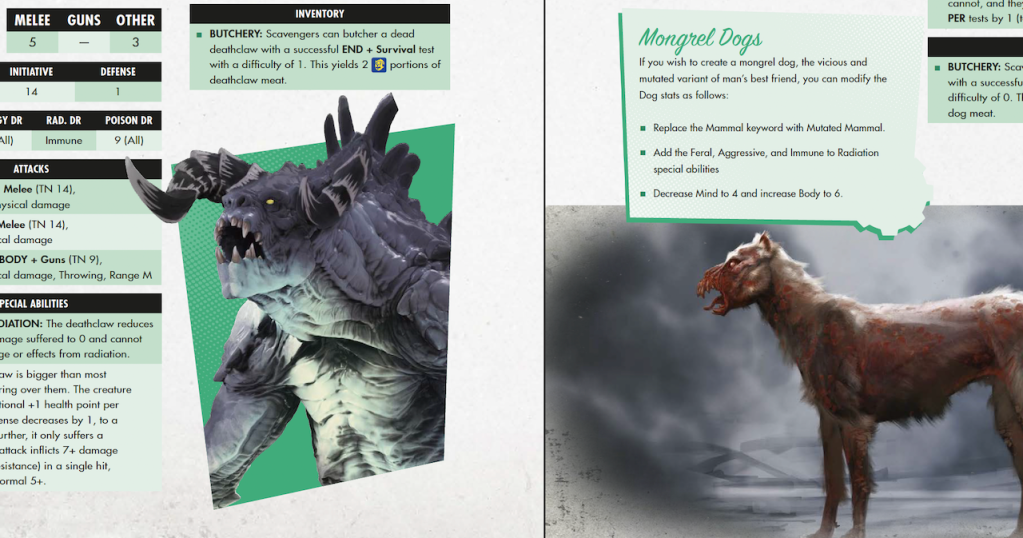
Chapter ten is Denizens of the Wasteland, covering a large selection of lifeforms PCs may encounter in the Commonwealth. As this book is based on Fallout 4, it covers the creatures from that game, so to the relief of many potential players there are no Cazadors in this book.
This chapter splits NPCs into two categories; Creatures, and Characters. Creatures are beasts and simple robots. Deathclaws, Bloodbugs, and Protectrons for example. They have a simplified stat block with just Body and Mind stats, and a list of their usual actions and what to roll.
Characters are for more advanced lifeforms, robots, and synthetics. From Super Mutants, to Mr Handys, to Synth Coursers. Anything you may have a conversation with. These are given a full S.P.E.C.I.A.L. array and tagged skills making them similar to PC builds.
I like this differentiation as the creatures are more likely to be used in simple encounters, but the Characters may be used in ongoing plots and need more detail. Also given are instructions on how to increase the challenge of an NPC, either by making them a stronger base version, or levelling them up to come back later. I like this section, and not just because I love monster books, but because it gives everything enough detail to be useful without overcomplicating things.
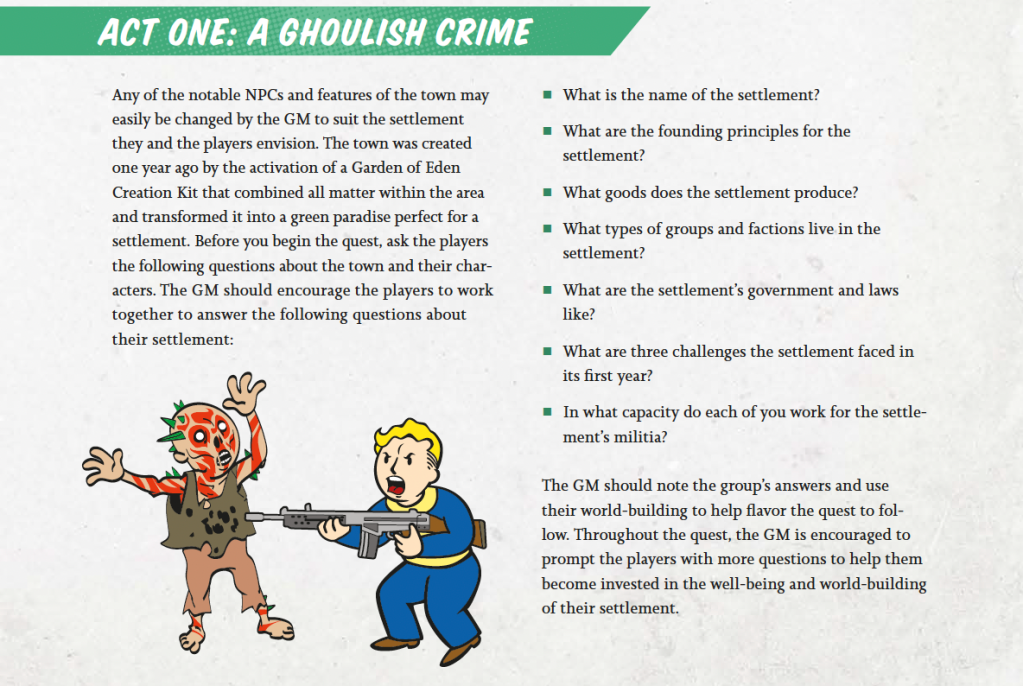
Chapter Eleven is “With a Bang, or a Whimper”, this is our example adventure. Without spoiling anything this adventure hits each type of situation one would expect when showing off how a system works. There are investigative parts, combat, travel, social interaction sections, and a big decision to make at the end. This can either be used following on from the adventure in the starter kit, or standalone. If you don’t have the starter set it has some excellent questions to fill in details collaboratively with your players. These questions are a really good guide for collaborative worldbuilding for GMs new to it, and I may use them in future games of this and other systems.
Overall a good book that has a more mechanically defined version of the 2D20 system that is more to my taste. Let down in a couple pf places by pointing you to a the GM’s toolkit, and by the non-standard dice. Both of these can be worked around, and the rest of the book more than makes up for it. I would run or play this quite enthusiastically.
Also, looking at Modiphius’ site at the already published add-ons, and with the TV series upcoming, I expect this to be a well supported line going forward with many supplements.
Final thought, if I were to run this, I may dig out my old Prima guides for the videogames to act as even more supplemental material.

